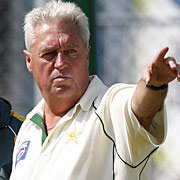The second test match between India and Australia has been a sensational one that was fought hard by both the teams. While adrenaline was flowing high and fortunes oscillated between the teams, it seems, more than the end-result, a few other incidents on the field has marred the beauty of this game. Unfortunately for the cricket fans worldwide, a lot of umpiring mistakes, misbehaviours of some players on either side, bad ethics from Australian senior players and lack of guts from some Indian players have resulted in India loosing this crucial match. Instead of looking into whether Ricky Ponting did right, Steve Buckner should be fired or Harbajan Singh really called Andrew Symonds a ‘monkey’, let us analyze how the situation can be improved with respect to officiating the game of cricket.
Root cause of umpiring errors
To begin with let me try to analyze the problems associated with umpiring a test match in cricket. Test match cricket , as I mentioned in another article sometime back, is the longest of all outdoor sports activities that spans across five long days, each day being comprised of seven hours of play. While players are busy switching their roles as bowlers, fielders and batsmen and take some rest, there is this species of white-shirts who stays there almost stand still, focus on each and every ball bowled in the match in the process of judging whether it is a noball, wide or a wicket taking delivery. On top of this he needs to track the time, number of overs bowled, look around for field placement mistakes and also track if the players on the ground are behaving well enough. Apart from being such a boring job, let me tell you that it takes a lot of stamina, energy and extreme focus much more than normal humans can afford to have to do this job effectively and judiciously.
Assuming that the best people who have that kind of energy and focus are available, still we have the element of human errors coming into picture. This is the second biggest issue a part of which can be helped with a third human sitting outside the ground or by using foolproof technologies, some of which have been already implemented. I will come to this part later.
The third most important thing is the biased nature of umpires itself. If you look into the history of any games, there has always been some allegations of the referees or umpires playing spoilsport after handing unjustified decisions. This part cannot be easily rectified, even if we go about picking the neutral umpires – which is already a process in place. So we have to look into how even neutral umpires can be trained or instructed to make minimal mistake or how to sort out an issue in case of doubt. Another related issue is how benefit-of-doubt situations has to be handled, probably which is not laid down as hard and fast rules.
A few answers, probably…
Umpires selection process & retirement age: As it looks, it is very hard to recruit on-field umpires with right skills and experience, these days. There are a very few people who want to do this job with passion while most ex-cricketers or people who have taken up cricket as a career, opt for more comfortable and high paid roles like commentators, match referees, coaches, selectors, mentors and what not. The recruitment process and the associated perks need to be made really attractive to keep this job a high profile one. If players can get millions if they win crucial tournaments why can’t umpires get similar money if they do a good job of officiating a series or tournament. Also, why can’t they be allowed to endorse brands and make more money? Such a move will surely make the job more interesting in terms of pay package and hence will attract larger number of people towards this career path.
There has to be more stringent rules on the age group of umpires as well. As I mentioned earlier, since the job demands a lot of energy and focus, one needs to be mentally and physically completely fit to handle the games. I haven’t heard of any outdoor game in this world which is officiated by 60 plus year old umpires or referees. Probably the retirement age should be reduced to 55 years for on field umpires in cricket as well. And regardless of the age, just like driver’s license scrutiny for elderly people, there has to be yearly test conducted for the on field umpires for their judgment skills as well as the physical fitness.
Changes in the umpiring system: The umpiring and decision making system needs some drastic changes. Every non-conclusive decision especially when close to ground catches are taken or close LBW appeals are made, the rule has to be changed in such a way that the on field umpires invariably discuss (mainly for ground level catches) If they cannot make a decision, they need to take help from the third umpire who can use the video footage to verify the same. There is a small percent of chance that the video footage is still not conclusive in which case the umpire can take benefit of doubt calls.
If the umpire is not to consult the third umpire, there has to be a provision whereby the captain of the fielding team can contest the decision by requesting for the third umpire’s assistance. At the moment, as I understand, this rule is restricted to only one call per match? This has to be made available for as many calls as the fielding captain might want to have. After all, how many such calls will be typically made? Not more than three or four per match, I would think, and it’s not that expensive or time consuming.
Noball calls: One of the complications in this game is that every ball bowled should be scrutinized for noballs by the main umpire. If a fast bowler delivers a ball at 150kmph the umpire has less than 0.5 seconds to check the bowler’s feet for a noball and subsequently focus on the batsman’s end for a possible leg-before- wicket, wide ball or leg-byes. One has to be extremely good at making this quick eye movement and still come out with a good judgment of the situation. I am just wondering why can’t the system offload this noball burden from the umpire? In other games like tennis, there are technologies available to make ‘out’ calls. I would assume that implementing such a light-and-camera based technology is no rocket science. Even if technology is not available for assistance, there can be another umpire near the short square-mid off region who can take a better call on a noball. This might sound funny. After all we have already two umpires on field but as you know some games like soccer which is again played on a larger field has got three or more on field and line referees. This additional umpire can even take a better call on run-outs on the non-striker’s end when the main umpire is rather busy avoiding running players or a ball! Yet another technology option is to allow the third umpire to make noball calls using a video camera focussed at the creese (already available) whereby he shouts ‘NO’ and is heard by the batsman as well as the umpires using the stump speakers – at the moment we only have a stump microphone and or camera there. The downside of the above rule is that, the batsman potentially looses the chance to react to a noball call, but again, how many times the noballs are resulted in sixes and fours? But as a positive, the chances of a batsman adjudged out for an actual noball overlooked by the umpire will be minimal here.
Fair game – yes, Gentlemen’s game – Not anymore! : Sometimes I do not understand the rules setup by the gentlemen of 1800s. Yes, cricket used to be gentlemen’s game but I guess not anymore. So expecting people to walk out when they feel they are out or consulting the opposite team’s captain to take the final call on a grounded catch or expecting the boundary line fielder to make right call on a 4 or 6 is wrong. We need to have a system where officials or technology makes the final calls and not the players. The captains of either side should not be allowed to come to such pre-match agreements where final decisions in doubtful circumstances rest with them. This can avoid some amount of criticisms about the spirit of the game etc.
It is also imperative that sledging of any kind should be banned from cricket – It’s not fair that a batsman surrounded by 5 or 6 fielders at a crucial juncture of the game receives bad and unethical treatment that could take his focus away from his main business. The stump microphones need to be amplified better to record this kind of unwanted talks. Basically if the batsman hears it, the same should be picked by the stump mic and can be used as evidence in tackling racism related sledging issues or otherwise.
Overuse of technology: Though technology can assist the game, it should not be taken to the extend where everything becomes mechanical. For example, an actual video footage can be used to make more accurate decisions but one should not rely on not-so-accurate methods like hawk-eye for taking LBW decisions.
These are some of the points that come to my mind right now, others might have better ideas. Regardless of that, it is time we reinvented the rules in the long term interest and true spirit of the game and adhered to the same.

 But when these people go through lean patches of their careers, the fans literally pounce on them. The readers may recall the plight of Greg Chappell when he was attacked by a mad cricket fan at the airport – the reason was that there were no cricketers selected from his state for the current Indian team. Bob Woolmer himself was allegedly assaulted by one of his players. It’s only a day back when the mad fans spoiled MS Dhoni’s new house that is being constructed, due to his duck and India’s failure in the match against Bangladesh.
But when these people go through lean patches of their careers, the fans literally pounce on them. The readers may recall the plight of Greg Chappell when he was attacked by a mad cricket fan at the airport – the reason was that there were no cricketers selected from his state for the current Indian team. Bob Woolmer himself was allegedly assaulted by one of his players. It’s only a day back when the mad fans spoiled MS Dhoni’s new house that is being constructed, due to his duck and India’s failure in the match against Bangladesh.